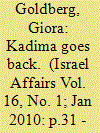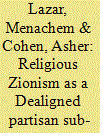| Srl | Item |
| 1 |
ID:
093897


|
|
|
|
|
| Publication |
2010.
|
| Summary/Abstract |
Kadima lost the 2009 elections to the Likud after it had come to power in the 2006 elections. While Kadima only lost one seat (28 instead of 29), and even remained the largest party in the Knesset, it had no chance of remaining in power. Kadima is the most important phenomenon in the Israeli party system in recent years. Despite the fact that it did not win the 2009 elections its influence on the political system has been enormous. After its victory in 2006 Labour and Likud tried to copy it, as happens with every successful product. The best way to relate to Kadima is as a completely different phenomenon, in terms of the standard tools of the historical party map and the traditional division into blocs. This approach denies the former five conceptions of Kadima: a classic centre party, a neo-centrist party, a centrist party in the left bloc, a faction in the Likud or a middle party.
|
|
|
|
|
|
|
|
|
|
|
|
|
|
|
|
| 2 |
ID:
187561


|
|
|
|
|
| Summary/Abstract |
During the second decade of the twenty-first century, Israel’s Religious Zionist camp has undergone a process of accelerated Dealignment of its partisan system, resulting in the transformation of the political parties comprising it into a Dealigned Partisan Subsystem. An example of this process can be found in the transformations that took place in the ‘Jewish Home’ Religious-Zionist political party led by Naftali Bennett. Within 9 years and seven election campaigns, the party succeeded in trying out the Open Camp Party model, experiencing a division led by Bennett himself, and finally reaching the verge of disappearing and once again initiating renewed revival attempts. The Dealignment of partisan systems includes a high level of voters’ mobility; a decline in the support of existing mainstream parties; a decline in voting rates; and a decline in the strength of partisan identification, while voting patterns become more personal. The partisan system itself changes during this stage, with old parties disappearing and others rising in their place, often only to disappear from the political map as quickly as they appeared. This article illustrates the extent to which the Religious-Zionist partisan subsystem in Israeli politics during the second decade of the twenty-first century until the 2022 elections campaign corresponds with most characteristics of a Dealigned system.
|
|
|
|
|
|
|
|
|
|
|
|
|
|
|
|